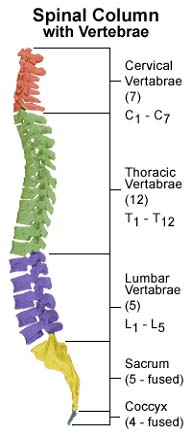A syndrome is a cluster of symptoms that often occur at the same time. Central cord syndrome is characterized by motor impairment in both the upper limb and lower limb, variable degree of sensory loss below the level of injury, and bladder dysfunction. Contrary to what you might think about a spinal cord injury, CCS usually results in greater weakness in the arms than the legs. The hands are especially affected. Normally the lower parts of the body are affected more than the upper parts by a SCI, but in CCS it is reversed. Further, there is usually no broken bone in the vertebrae in SCI patients.
Central cord syndrome is more common among elderly perspons with long-standing cervical spondylosis but it can occur in younger persons with injuries.
Nerve fibers carrying the motor and sensory impulses for lower limbs are located in the most peripheral part of the cord, whereas fibers carrying impulses for the upper limb and voluntary bowel and bladder function are more centrally located. Sacral tracts are located peripherally and are usually spared from injury.

Although there might not be broken bones, there is trauma to the spinal cord that causes central cord syndrome. The most common mode of injury is hyperextension of the cord. The spinal cord is pinched by a ligament called the ligamentum flavum or anterior compression by the osteophytes.
The vertebral discs can herniate and cut off function. Sometimes, central cord syndrome may be a result of fracture dislocation and compression fracture, especially if the spinal cord is congenitally narrow. Central cord syndrome can also be caused by hematomas and blood build-up around the cord.
Older people sometimes have weak vertebrae and discs, which increases risk for CCS when there is a hyperextension.
Symptoms of central cord syndrome include weakness and loss of feeling in limbs, loss of pain and temperature sensation, and loss of sensation of light touch and position.

Site of lesion in CCS
X-rays: Fracture and dislocation can be diagnosed and flexion/extension view will be helpful in diagnosing stability of ligaments.
CT scan: CT scan of cervical spine may show a narrow spinal canal.
MRI scan: MRI can show the presence of hematoma, impingement from bone or intervertebral disc.
Gait kinematic analysis in patients with a mild form of central cord syndrome
There is no cure for central cord syndrome. Treatment is usually supportive and includes medical and surgical treatment as well as physical therapy. Doctors rarely do surgery on CCS patients. Physical therapy mainly helps to preserve the range of motion. Often the patient does recover function, but that is natural healing of the body and not due to anything the doctors do.
It is common for some but not all function to be recovered over time. If the syndrome was caused by trauma, prognosis is better than if it is related to tissue degeneration from another cause. Patient receiving treatment soon after onset recover better, too. Walking is recovered in most cases with some residual disability. Improvement starts in the legs, followed by the bladder and is lastly seen in the arms. Younger people generally do better than older people when it comes to recovering function.
Evidence-based management of central cord syndrome.
National Spinal Cord Injury Association

